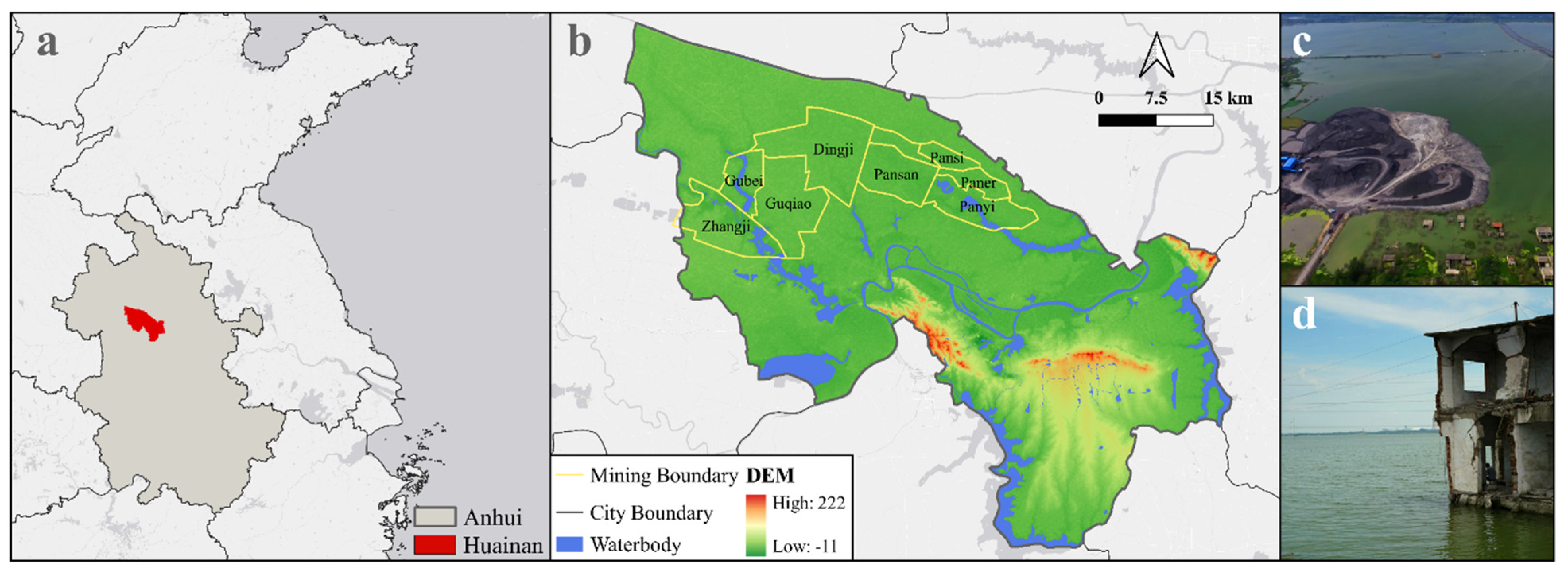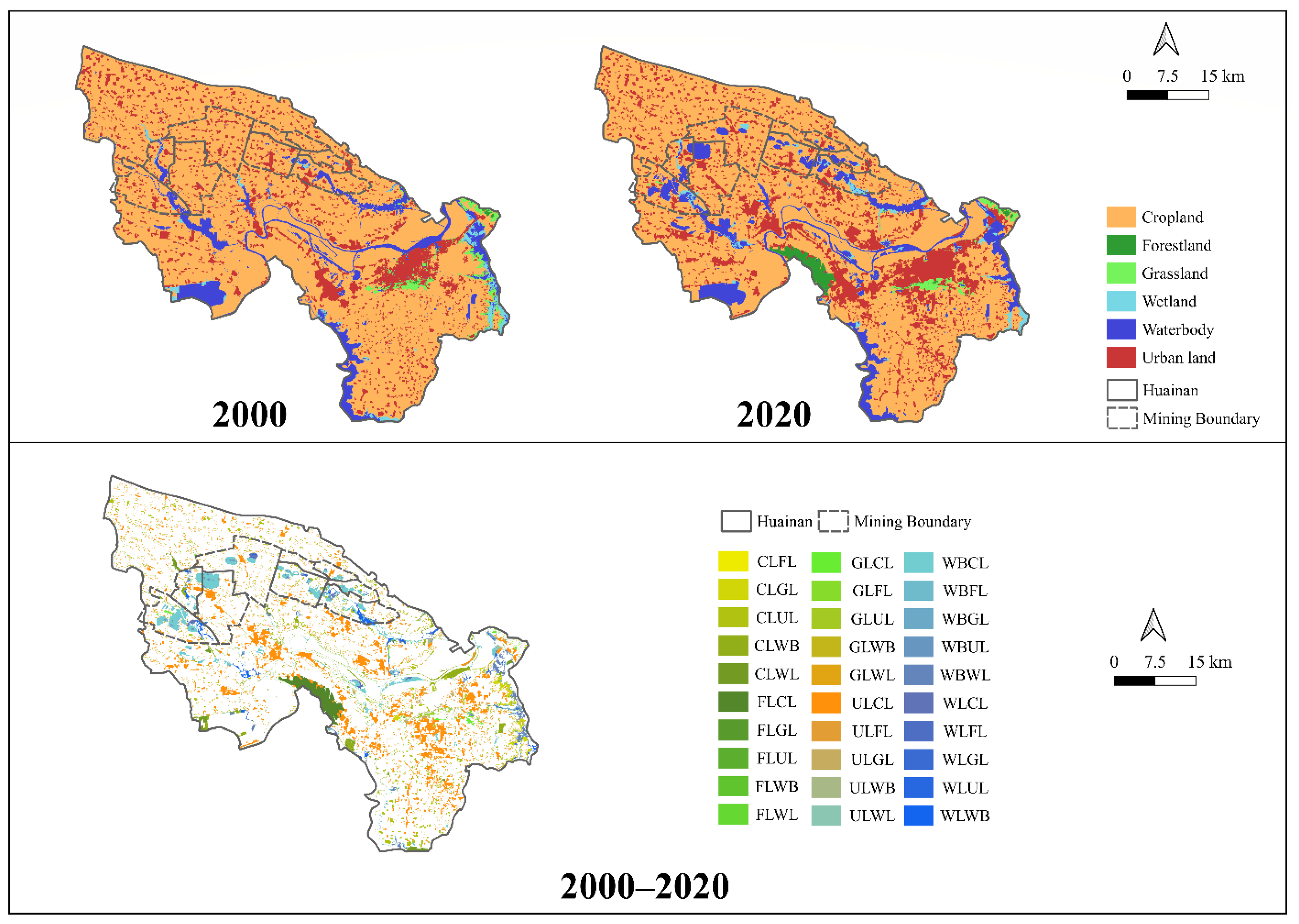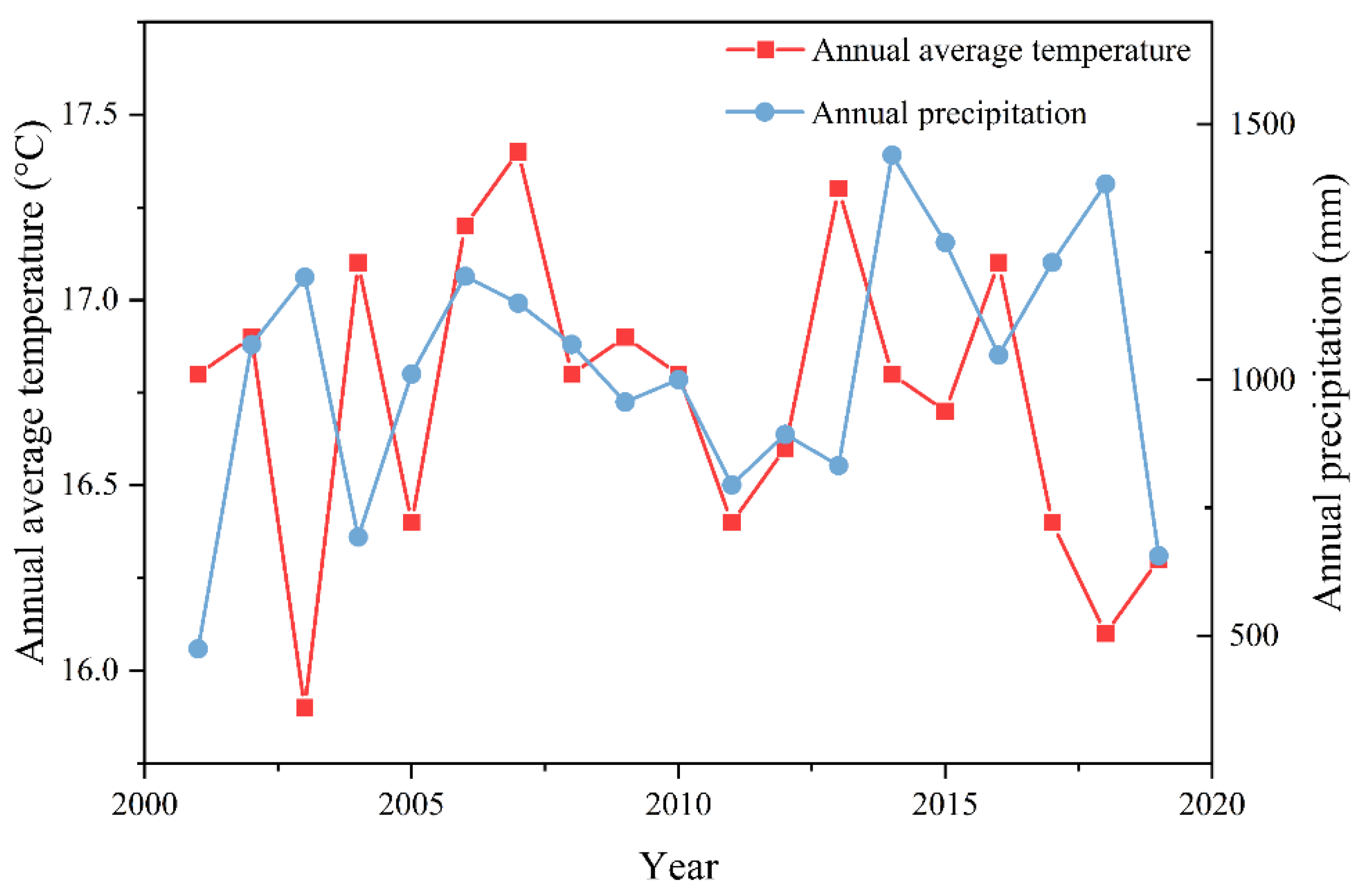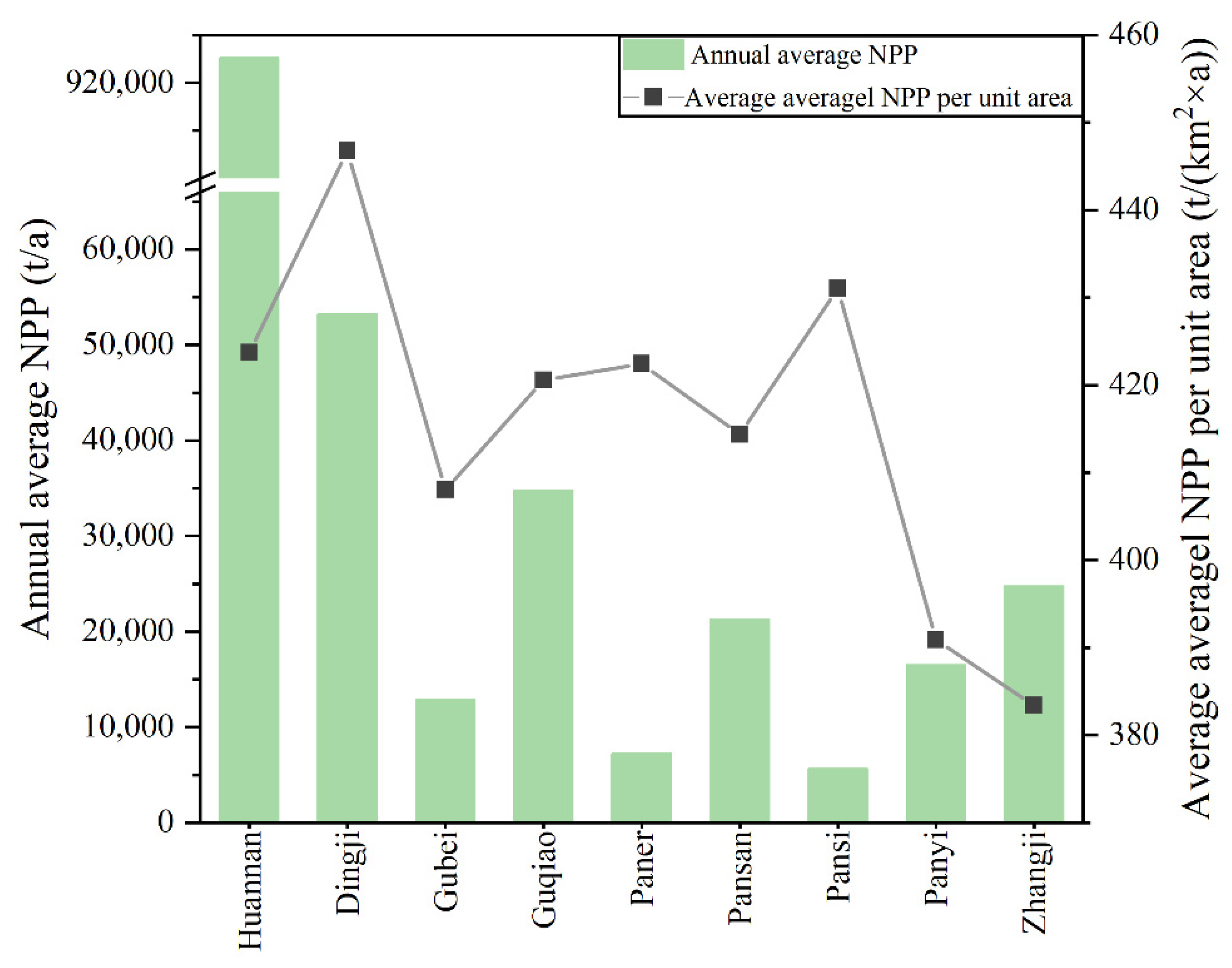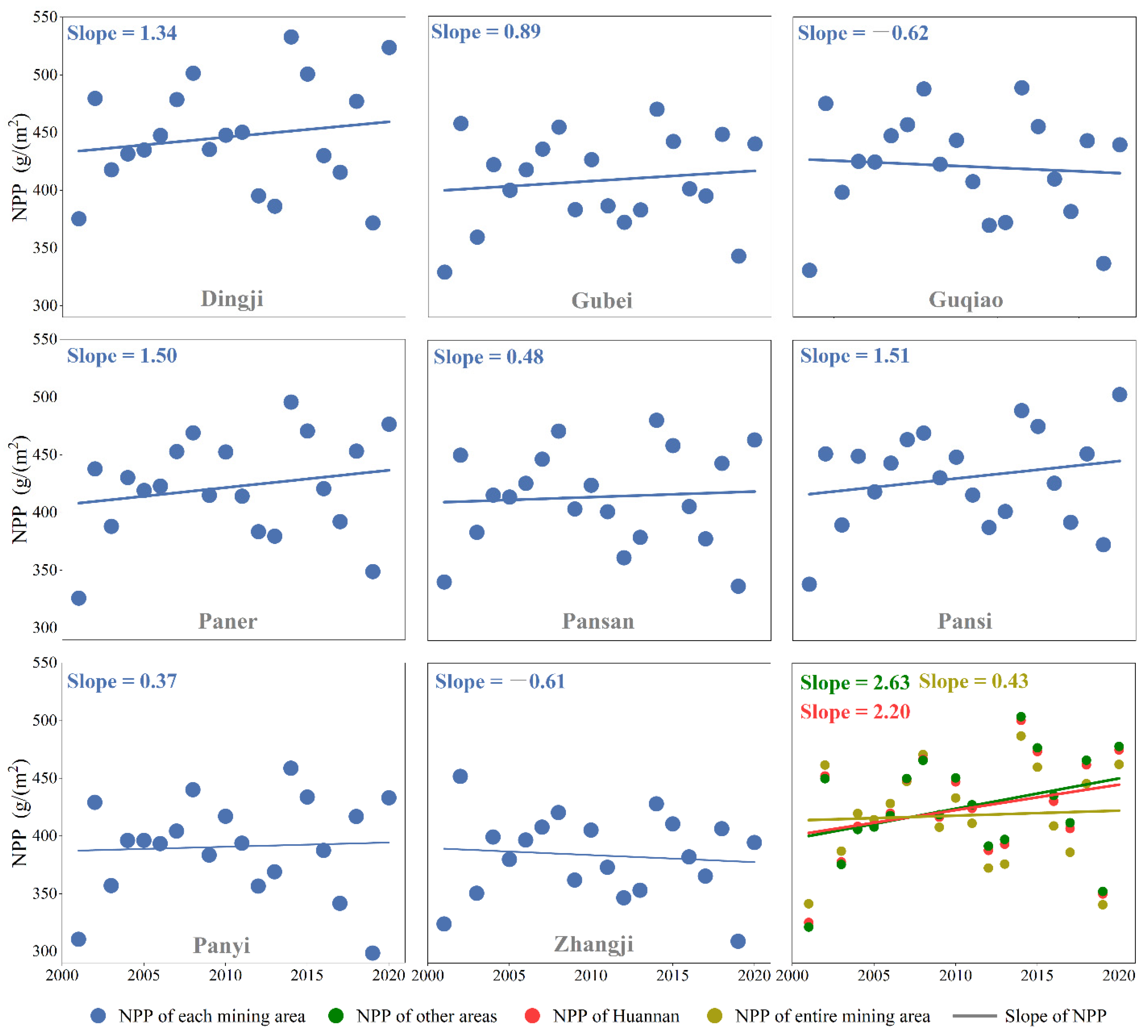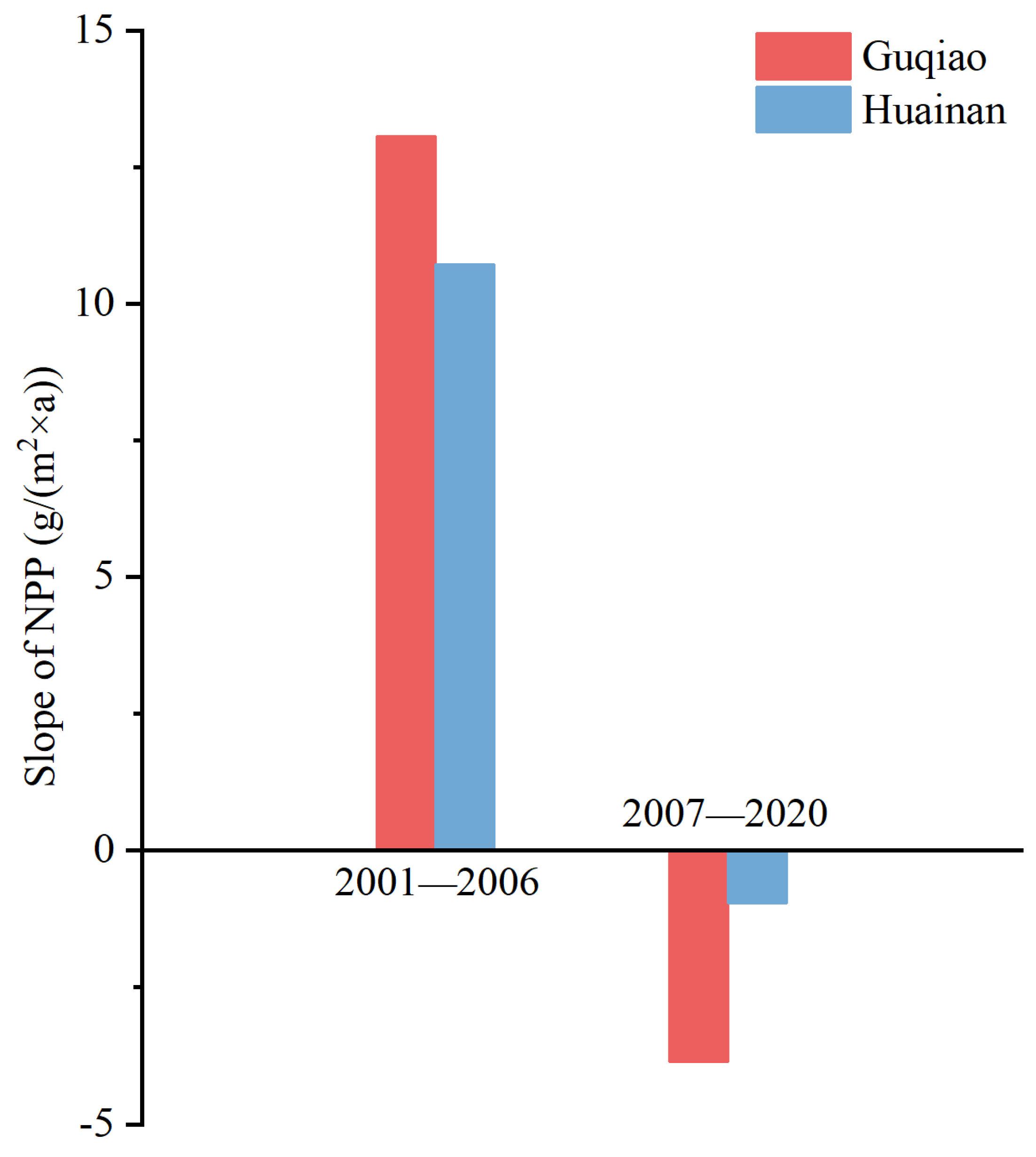1. Introduction
The exploitation and utilization of coal resources promote the rapid development of the national economy and inevitably degrade the ecological environment in mining areas [
1,
2]. In eastern China’s areas with high groundwater levels, coal mining has resulted in significant surface subsidence and the formation of seasonal or permanent water accumulation, resulting in drastic changes in the original land-use structure. The succession of terrestrial ecosystems has a profound impact on carbon sequestration, and other ecological functions directly affect the daily production and life of the people in the region and the sustainable development of society [
3,
4,
5]. Dozens of cities with coal resources (cities where coal mining and processing are the leading industries) are located in eastern China, where development and protection have always been the eternal contradiction around the development and utilization of resources. The ecological environment in these cities worsens with coal mining [
6]. The Chinese government released the implementation plan of the 14th Five-Year Plan for promoting high-quality development in resource-based areas in 2021, which set higher requirements for the transformation of resource-based cities. In the same year, China put forward the goals of a carbon peak in 2030 and carbon neutrality in 2060. It is urgent to protect the ecology of coal-resource-based cities and their mining areas, reduce carbon emissions, and increase carbon sinks. Revealing the change characteristics of the land structure and the succession process and influencing factors of carbon sink function under coal mining is of great significance in formulating ecological-restoration measures in mining areas and realizing the dual-carbon target [
7,
8].
Net primary productivity (NPP) refers to the total amount of dry organic matter accumulated in a unit of time and area, and is the basis of the study of matter and energy movement in an ecosystem [
9,
10]. This indicator can accurately reflect the health status of the ecosystem, and is an important indicator to measure the function of the ecosystem. It is widely used to monitor the carbon cycle in different regions [
11,
12]. NPP is closely related to the biological characteristics of the vegetation itself and regional environmental factors such as precipitation and temperature [
13]. Land-use and land-cover change (LUCC) is the most direct manifestation of the interaction between coal mining and the natural environment [
14]. The ecosystem’s type, structure, and function will change with the LUCC, affecting the mining area’s carbon-sequestration capacity [
15,
16]. Therefore, the study of how the temporal and spatial responses of land-use structures and NPP are driven by coal mining helps to reveal the processes of coal mining that affect the ecosystem, and is of great significance to balancing the relationship between resource mining and the environment.
The mechanism between NPP and natural environmental factors has been one of the hot issues for domestic and foreign scholars. Many scholars have studied the temporal and spatial distributions of NPP and its influencing factors from no visual angle. Michael used the LPJ-DGVM model and global HANPP assessment data to estimate and analyze the loss of NPP caused by dryland degradation due to human activities [
17]. Gray studied the effects of population density, species richness, and land use on the spatial distribution of NPP in Australia through a correlation analysis and spatial regression [
18]. Peng [
19] and Yang [
20] respectively took Beijing and the Yangtze River Basin as their research object to analyze the impact of LUCC on NPP.
Some scholars have studied the NPP variation in mining areas. Xie [
21] used the EOS/MODIS NPP data set to explore the trend of NPP in the Shendong mining area and conduct a correlation analysis of climate factors. The results showed that NPP in the mining area was lower than the national average, and precipitation was the main climatic factor affecting NPP change. Hou used the CASA model to calculate NPP, and found that the change rate of NPP in the ecological damage area affected by coal mining was the fastest, and the decrease in NPP was positively correlated with the production capacity of the coal mine [
22]. The mining of high groundwater levels causes damage to the surface ecological environment that is challenging to repair. There is little analysis of NPP in coal-resource-based cities and their mining areas with high groundwater levels, and the change law of NPP disturbed by coal mining is unclear.
To quantitatively describe the impact of underground mining on land use and NPP at the surface, we proposed a set of accounting processes. Taking Huainan City and its eight mines as an example, this paper studied the changes and differences in land-use structures in urban areas and mining areas between 2001 and 2020, obtained the total amount and change trend of NPP in the past 20 years through a time-series-analysis method, and then determined the spatial relationship between the degree of surface collapse and NPP through a spatial correlation analysis based on the impact range of coal mining obtained using a probability integral method. This method enriched the calculation method of carbon sequestration function in the mining area, and the results obtained can provide valuable data for local ecological restoration and carbon neutrality strategies.
4. Discussion
4.1. Difference in LUCC between City and Mining Areas
The change in land-use structures driven by coal mining was obviously different from that of urban land-use structures, which was consistent with the research conclusions of Wang [
33]. He pointed out that LUCC in mining areas was different from that in general areas, and high intensive mining of coal resources was one of the essential factors that affected the evolution of land use. Xiao [
34] pointed out that underground mining activities in areas with high groundwater levels led to a drastic change in land use and tremendous pressure on the ecological environment. For urban land types other than mining areas, the determinants of land-use-structure change were complex, mainly in urbanization, and the change in land-use structure was characterized by a significant increase in urban land use. Our results also confirmed the existence of this problem. With coal mining, a large amount of cropland changed into waterbodies in the Huainan mine area. This conversion was significantly different from other areas outside the mine area. The mining activities in this area will continue for several decades, and more attention should be paid to protecting land resources in the mining area.
4.2. Many Factors Influenced the Change in NPP
Wu [
35] found that climate change significantly affected NPP in the Yangtze River Delta agroforestry areas. The results of Gao [
36] showed that NPP presented significant seasonal and interannual changes in the Tibetan Plateau. In this study, we found that the Huainan NPP was significantly affected by rainfall and had a weak correlation with air temperature. At the same time, coal mining was also an essential factor that affected NPP. Although the average annual NPP of each mining area fluctuated with climate change, the changing trend of NPP in the mining area was still significantly different from that in Huainan City. On the one hand, under the same natural conditions, the growth rate of NPP in mining areas was considerably less than in non-mining regions. On the other hand, the difference in the NPP change trend between pre-mining and mining in the same mining area was very significant. Through a bivariate spatial correlation analysis, we found that the more serious the damage caused by coal mining, the more pronounced the trend in NPP reduction, which was mainly due to the transformation of the terrestrial surface ecosystem to the aquatic ecosystem caused by coal mining. In the area seriously damaged by coal mining, the vegetation was extensively damaged, and the NPP changed under the influence of vegetation.
4.3. Suggestions for Local Development
Large-scale coal mining in resource-based cities has seriously affected the ecological environment of the cities, resulting in a lower NPP in mining areas than in other areas of the cities. In China’s promotion of the carbon-neutralization goal, it is essential to estimate the change of the carbon sink function in resource-based cities and mining areas. The accounting and analysis path of NPP change in cites with a high phreatic water level and mining areas proposed in this study can provide a fast and effective means for this work. Mining enterprises and management departments can calculate the carbon sink loss year by year in combination with the coal-mining progress to provide reference data for the next mining and ecological restoration work. Mining in high-groundwater-level mining areas will lead to dramatic changes to the surface. In addition to eastern China, such mining areas are also distributed in the United States, Myanmar, Vietnam, Malaysia, and the Czech Republic. The work of this paper is also applicable to these areas.
In the future, the management of Huainan should focus on the ecological environment of the mining area. Since the area is a high-water mining area, much of the arable land would have been lost to the water if ecological restoration had been carried out after mining had ended. Therefore, the mining process should be carried out simultaneously while seizing the best governance opportunity and initiating timely restoration of damaged ecological environments. To avoid the abandonment caused by land-subsidence water, the stability of NPP should be maintained before and after mining. In this way, the contradiction between exploitation and utilization of coal resources and environmental protection can be alleviated, and the mining activities can be developed in a green and sustainable direction.
While carrying out ecological construction, resource-based cities need to vigorously develop clean industries such as renewable energy and modern service industries, optimize the allocation of resources, and promote the greening of initiatives to reduce carbon emissions, thereby improving regional environmental quality. The government should increase investment in low-carbon technologies, reduce carbon emissions, encourage enterprises and the public to participate in environmental governance, and promote the early realization of China’s dual-carbon target.
4.4. Limitations
The land-use data selected in this study was Globeland30 data. Although it is widely used, and the overall accuracy is 85.72%, we did not verify the accuracy of this data set in Huainan City. In future research, we should further verify the accuracy of the land classification and the rationality of the land-type division. The reliability of the NPP data provided by UCGS needs to be further confirmed. Moran’s I is applicable to infer the spatial distribution relationship of the two factors. In order to more accurately explore the relationship between coal mining and the carbon sink function, it is necessary to conduct on-site sampling.
5. Conclusions
To make up for the deficiency of existing studies in the analysis of carbon sink changes in high-groundwater-level mining areas, we took Huainan and its mining areas as an example, analyzed the temporal and spatial characteristics of LUCC and the trend in NPP from 2001 to 2020, and reached the following conclusions:
- (1)
Under coal mining, LUCC’s type was mainly the change from farmland to waterbodies and wetland, while the non-mining area was primarily changed from farmland to urban land. Between 2000 and 2020, 22.5% of the land in mining areas changed, compared with 3.2% in Huainan.
- (2)
NPP varied with rainfall fluctuation and was restricted by coal-mining factors. NPP in the mining area was 0.43 g/(m2×a), which was lower than 2.63 g/(m2×a) in the non-mining area. In the Guqiao mine, NPP increased more before mining than in Huainan, but after 2006, NPP decreased by more than four times as much as in Huainan.
- (3)
The spatial correlation between mining disturbances and NPP was obvious. The more serious the damage caused by coal mining, the smaller the value of the NPPslope and the larger the bivariate Moran Index.
This study revealed the characteristics of LUCC and the temporal–spatial response and driving factors of NPP in coal-resource-based cities with high phreatic water levels in East China. It can provide theoretical and data support for urban ecological structure–function planning and sustainable-development strategies.
